Honda Accord
 |
|
| Manufacturer | Honda |
|---|---|
| Production | 1976–present |
| Predecessor | Honda 1300 |
| Class | Compact (1976–1993) Mid-size (1994–present) |
| Layout | FF layout |
The Honda Accord is series of midrange automobile manufactured by Honda since 1976 and sold in most automotive markets throughout the world. The Accord became the first Japanese car to be produced in the US in 1982, when production commenced in Marysville, Ohio at Honda's Marysville Auto Plant. It is also produced in Guangzhou, China since the 1999 inception of the Guangzhou Honda Joint Venture. The Accord has achieved considerable success, especially in the United States, where it was the best-selling Japanese car for 20 years (1982-97), topping its class in sales in 1991 and 2001, with around ten million sold there in total.[1] Numerous test, past and present count the Accord as one of the world's most reliable vehicles.[2]
Over the years, Honda has offered several different body styles and versions of the Accord, and often vehicles marketed under the Accord nameplate concurrently in different regions differ quite substantially. It debuted in 1976 as a compact hatchback, though this style was dropped in the 1980s, as the lineup was expanded to include a sedan, coupe, and wagon. By the Accord's sixth generation in the 1990s, it evolved into a intermediate vehicle, with one basic platform but with different bodies and proportions increase its competitiveness against its rivals in different international markets. For the current generation of Accord released for the North American market in 2008, Honda again has chosen to move the model further upscale and increase in its size. This pushed the Accord sedan from the upper limit of what the United States Environmental Protection Agency defines as a mid-size car to just above the lower limit of a full-size car[3], with the coupe still rated as a mid-size car.
Concept
Honda chose the name Accord, reflecting "Honda's desire for accord and harmony between people, society and the automobile."[4] The initial design was changed to a fuel efficient, low emission vehicle since it was introduced during the fuel crises of the 1970s. In the United States and Japan, a version was produced using Honda's CVCC technology, meeting emission standards of the 1970s and early 1980s without a catalytic converter.
Like the smaller Honda Civic, the Accord used front-wheel drive and a transverse engine layout.
First generation (1976–1981)
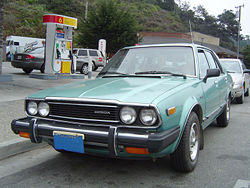 |
|
| Production | 1976–1981 |
|---|---|
| Assembly | Sayama, Japan |
| Class | Compact |
| Body style(s) | 3-door hatchback 4-door sedan |
| Engine(s) | 1.6 L EL1 I4 1.8 L EK1 I4 |
| Transmission(s) | 2-speed automatic 3-speed automatic 5-speed manual |
| Wheelbase | 93.7 in (2380 mm) |
| Length | 162.0 in (4115 mm) |
| Curb weight | 2,000 lb (907 kg) |

The first generation Honda Accord was launched in 1976 as a three-door hatchback with 68 hp (51 kW), a 93.7-inch (2,380.0 mm) wheelbase, and a weight of about 2,000 pounds. It was larger than the tiny Civic at 162 inches (4,115 mm) long. The Accord sold well, due to its moderate size and great fuel economy. It was the first Japanese small car with features like cloth seats, a tachometer, intermittent wipers, and an AM/FM radio as standard equipment. In 1978 an LX version of the coupe was added which came with air conditioning, digital clock, and power steering. In 1979 a four-door sedan was added to the lineup, and power went to 72 hp (54 kW) with the introduction of the 1,751 cc (106.9 cu in) EK-1 engine. In 1980 the optional two-speed automatic of previous years became a three-speed automatic. Slightly redesigned bumper trim, new grilles and taillamps, and remote mirrors on the 4-door (chrome) and the LX (black plastic) models. The CVCC badges were deleted. In 1981 an SE model was added for the first time, with novio-leather seats and power windows. Base model hatchbacks received the same smaller black plastic remote mirror that the 4-door, LX, and SE 4-door received at the same time. Instrument cluster revised with mostly pictograms, instead of the worded warning lights and gauge markings. Nivorno Beige (code #Y-39) replaced with Oslo Beige (#YR-43). Dark brown was discontinued, as was the bronze metallic. Shifter redesigned to have a stronger spring to prevent unintentional engagement of reverse, instead of the spring-loaded shift knob of the 1976 through 1980 model cars.
The Accord competed with Japanese competitors Toyota Corona, Nissan Bluebird, Mazda Capella, and the Mitsubishi Galant.
The first few generations of Hondas suffered from rustproofing issues in areas where salt is used to melt road ice. Under these conditions, it was not uncommon for the strut towers to rust out and fail, turning the car into a parts car.
Second generation (1981–1985)
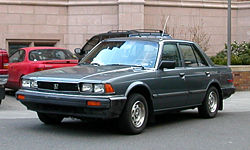 |
|
| Also called | Honda Vigor(Japan) |
|---|---|
| Production | 1981-1985 |
| Assembly | Marysville, Ohio, USA Sayama, Saitama, Japan |
| Class | Compact |
| Body style(s) | 3-door hatchback 4-door sedan |
| Engine(s) | 1.6 L EL1 I4 (CAN) 1.8 L EK1 I4 ('82,'83 US) 1.8 L ES2 I4 ('84,'85 US) 1.8 L ES3 I4 ('85 US) |
| Transmission(s) | 4-speed automatic 5-speed manual |
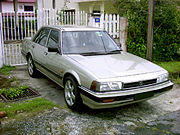
Debuting in 1981 in Japan and Europe, and as a 1982 model in North America, in addition to being produced in Japan, this generation of the Accord became the first to be built in the USA, at Honda's plant in Marysville, Ohio. Since its first year in the American market, it also became the best-selling Japanese nameplate in the US, holding that position for about 15 years. In Japan, a sister model called Honda Vigor was launched simultaneously with the new Accord.
Modernizing both the interior and exterior, the second generation Accord was mechanically very similar to the original, using the same 75 hp (56 kW), 1,751 cc (106.9 cu in) EK1 CVCC engine. Fuel economy increased by nearly 15%. Vastly improved quality control, however, made this one of the most reliable cars on the US market, a position it still holds today. This automobile included popular features of the time such as shag carpet, velour cabin trim and chrome accents. An optional extra on the 1981 Accord was an Electro Gyrocator, the world's first automatic in-car navigation system.[5] Models were available in Silver, Sky Blue, and Beige. The LX hatchback offered a digital clock and slightly higher fuel economy (due to its lighter weight.)
The U.S. Department of Transportation had stringent lighting requirements which prevented Honda from including the aerodynamic molded headlight units which were used on Australian, European and Japanese Accords. The U.S. D.O.T. required the use of rectangular sealed beam glass units to prevent fogging and allow for easy and readily available replacement of units damaged by rocks or other road hazards. U.S. Accords were also required to have a side marker light installed on the side of the rear fenders. German Accords included additional reflectors which were embedded into the rear bumper as well as washer sprayers for front and rear lamps. The Japanese Accords were unique from all other markets in that they included adjustable ride height control and were unique in that their side view mirrors were installed on the mid forward fenders.
In 1983, Honda upgraded the automatic transmission to a four speed, a major improvement over the three speed Hondamatic. The manual, five speed transmission remained unchanged. A 120 mph (193 km/h) speedometer replaced the earlier 85 mph (137 km/h) unit. The Special Edition (SE) featured, novio-leather seating, power windows, power sunroof and locks. Columbus Slate Grey was added as a color option.
By 1984, Accords sold in the eastern U.S. were produced at the new Marysville plant, with quality considered equal to those produced in Japan. The body was restyled with a slightly downward beveled nose; and, the slightly more powerful ES2 1,829 cc (111.6 cu in) CVCC powerplant was used, bringing 86 hp (64 kW). The redesign in 1984 is often called the second series of the second generation. Honda integrated side marker lights into the side of the tail light units which satisfied the D.O.T.'s side marker requirements and ended the difference between cross market tail light configurations. European Accords, however, now included signal lights on the forward fenders, just behind the wheel well. The U.S. Accord still lacked the molded head light units which were used everywhere else.
The LX offered velour upholstery, auto-reverse cassette stereo, air conditioning, cruise control, power brakes, power steering, power windows & power locks (sedan only), a digital clock, and roof pillar antenna, along with thick black belt moldings and integrated bumpers. Flush plastic mock-alloy wheels covers instead of caps on steel wheels that resembled the trend-setting Audi 5000. Supplies were tight, as in the Eastern states, the wait was months for a Graphite Gray sedan, a then-popular color. The LX hatchback was the only 1984 version of the Accord to include dual outside mirrors.
The 1984 sedan (regular and LX) was available in four exterior colors, Greek White and three metallic options: Graphite Gray, Regency Red (burgundy), and Stratos Blue (steel). The regular hatchback was available in Greek White, Dominican Red, and the metallic Stratos Blue. The '84 LX hatchback came in three metallic colors only: Graphite Gray, Regency Red, and Copper Brown. These models were on U.S. roads well past the turn of the century.
In 1985, the Special Edition returned as the SE-i, capitalizing on the final year of the second generation's production. A fuel-injected, 110 hp (82 kW) non-cvcc ES3 engine was exclusive to this model. The moniker, SE-i, was adapted from the SE trim, but included the "-i" to signify the higher trim level's fuel-injected engine. This 12-valve, 1,829 cc (111.6 cu in) engine was the first non-CVCC engine used in an Accord, and was the same basic engine design used by Honda until 1989. Like the previous SE trim in 1983, the SE-i featured novio-leather seating, power moonroof, bronze tinted glass, a premium sound system with cassette, and 13" alloy wheels.
Overseas versions of the Accord were slightly different from the North American Versions of the car, and had some features not offered in that market.In 1981, the Accord offered an Air suspension in the Japanese market. From 1983 in Japan and 1984 in Europe, the Second Generation Accord was available with Anti-Lock Brakes (Called A.L.B) as an option. This system also had 4 wheel disc brakes. Fuel Injection was made available in 1984 in Japanese market, it took a year to arrive in the NA and European Market. There was also an upmarket trim line called the Vigor.
Third generation (1986—1989)
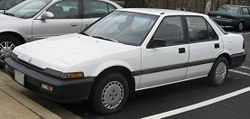 |
|
| Also called | Honda Vigor(Japan) |
|---|---|
| Production | 1986-1989 |
| Assembly | Marysville, Ohio, USA Sayama, Japan |
| Class | Compact |
| Body style(s) | 2-door coupe 3-door hatchback 4-door sedan 3-door station wagon (Aerodeck) |
| Engine(s) | 2.0L 98 hp (73 kW) I4 2.0L 120 hp (89 kW) I4 |
| Transmission(s) | 4-speed automatic 5-speed automatic 5-speed manual |
| Wheelbase | 102.4 in (2601 mm) |
| Length | Hatchback: 174.8 in (4440 mm) Sedan & Coupe: 179.7 in (4564 mm) 1986-88 Coupe: 179.1 in (4549 mm) |
| Width | Hatchback & 1986-88 Coupe: 66.7 in (1694 mm) Sedan & 1989 Coupe: 67.4 in (1712 mm) |
| Height | Hatchback & 1986-88 Coupe: 52.6 in (1336 mm) Sedan: 53.4 in (1356 mm) 1989 Coupe: 52.7 in (1339 mm) |
| Fuel capacity | 15.9 US gallons (60.2 L/13.2 imp gal) |
The third generation Accord was introduced in Japan and Europe in 1985 and North America in 1986. It had a very striking shape, bearing a resemblance to the second and third generation Preludes. One notable feature was the flip-up headlights, unusual for a sedan. Sedan models sold on the European market featured fixed headlights and a different taillight cluster.
This Accord became the first Honda to employ double-wishbones at both the front and rear ends -- a layout that spread to the Civic and Prelude in 1988 and the Integra in 1990. While more expensive than competitors' Macpherson strut systems, this setup provided better stability and sharper handling for the vehicle. All have front and rear stabilizer bars as well. Brakes were either large 4-wheel discs with twin-piston calipers (as in the JDM Si model), smaller 4-wheel discs with single piston calipers, or a front disc/rear drum system. ABS was also available as an option on the 4-wheel disc brake models, though not in North America. Base model Accords rode on 13-inch steel wheels with hubcaps with more expensive models having the option of 14-inch alloy wheels.
The Accord's available engines included the following: In Japan, the A18A, B18A, and B20A; in Europe and Canada, the A16A1, A20A4, B20A2 and B20A8; in North America (excluding Canada): the A20A1, A20A2, A20A3 and A20A4 (in Japanese and European models).
The Accord's interior ranged from spartan to luxurious. In the Japanese home market, the Accord was available with a full power package, leather upholstery, heated seats, heated mirrors, a digital instrument cluster, and even climate control. The Accord Aerodeck (a three-door hatchback Accord made for Japanese and European consumers) had Recaro seats. Export Accords were not available with most of these options, presumably (and in the USA in particular) because Honda was seen as a builder of economy cars, and not to cannibalize sales from the recently introduced Acura line.
The Accord was available in several body styles throughout the world, including a 4 door sedan, 2 door coupe, 3 door liftback, and 3 door "Aerodeck" which resembled the third generation Civic hatchback subcompact and was not sold in US or Canada.

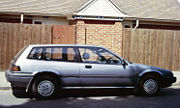
Fourth generation (1990–1993)
 |
|
| Production | 1990–1993 |
|---|---|
| Assembly | Marysville, Ohio, USA Sayama, Japan |
| Class | Compact |
| Body style(s) | 2-door coupe 4-door sedan 5-door station wagon |
| Engine(s) | 2.2 L F22A I4 |
| Transmission(s) | 4-speed automatic 5-speed manual |
| Wheelbase | 107.1 in (2720 mm) |
| Length | 1990-91 Coupe & Sedan: 184.8 in (4694 mm) 1990 Wagon: 186.0 in (4724 mm) 1992-93 Coupe & Sedan: 185.2 in (4704 mm) 1992-93 Wagon: 186.8 in (4745 mm) |
| Width | 1990-91: 67.9 in (1725 mm) 1992-93 Coupe & Sedan: 67.1 in (1704 mm) 1992-93 Wagon: 67.5 in (1715 mm) |
| Height | 1990-91 Coupe: 53.9 in (1369 mm) 1990-91 Sedan: 54.7 in (1389 mm) 1991 Wagon: 55.1 in (1400 mm) 1992-93 Coupe: 52.2 in (1326 mm) 1992-93 Wagon: 53.2 in (1351 mm) 1992-93 Sedan: 52.8 in (1341 mm) |
| Curb weight | 2,822 lb (1,280 kg) |
| Fuel capacity | 17 US gallons (64.4 L/14.2 imp gal) |
| Related | Honda Ascot Honda Ascot Innova Honda Inspire Acura Vigor Rover 600 |
A larger Honda Accord based on the "CB" chassis was launched in Japan. This generation was the first not to feature a three-door model, and the first one to be exclusively sold by the Honda Clio dealer network in Japan. A sister car, called Honda Ascot, differing only slightly from the JDM Accord sedan, was launched for sale in the Honda Primo stores that also carried previous-generation Accords. On the other hand, the Honda Vigor, previously closely related to the Accord, became a rather different model, fitted with longitudinally-mounted inline five-cylinder engines.
The more conservative Accord now bore a resemblance to the first-generation Acura Legend and the third generation Prelude. The Accord had matured into a larger car now approaching the likes of the midsize Ford Taurus, but was still given "compact" status.
This was one of the first US production cars to feature optic reflectors with completely clear lenses on the headlamps replacing the more conventional lens diffused lighting. Unlike most manufacturers moving away from traditional sealed beam lighting, Honda chose to transition to a multi-reflector headlight style while maintaining the use of a glass lens instead of polycarbonate as is most common today.
For this fourth generation Accord Honda made significant engineering design improvements. All Accords sold in North America came with a completely new 2.2 liter electronic fuel injected engine standard, replacing the previous 2.0 liter 12-valve model from the past generation. A first in the automotive industry for a non-luxury vehicle was its all aluminum power train (engine and transmission). Also noteworthy, all Accords equipped with automatic transmissions used an electronically controlled rear engine mount to reduce low frequency noise and vibration. The mount contained 2 fluid filled chambers separated by a computer controlled valve. At low engine speeds, fluid routed through the valve damping vibration. Above 850 rpm, fluid routed around the valve making the engine mount stiffer.
In the US, the LX-i and SE-i designations were dropped, being replaced with the DX, LX, and EX trim levels. The Canadian Accord trim levels varied slightly from the US models with LX, EX and EX-R roughly corresponding to the American DX, LX, and EX, respectively. Fourth generation EXi Accords sold in Australia and New Zealand offered the same 4-wheel steering technology as was available optionally on the US Honda Prelude. US Accord Coupes were available in DX and EX trims (LX and EX-R in Canada).
A 125 HP 4-cylinder engine was offered the DX and LX models, while the EX received a 130 hp (97 kW) version. Cruise control was dropped from the DX sedan, with air conditioning remaining a dealer-installed option. The LX kept the same features as the previous generation including air conditioning, power windows, locks, and mirrors. The EX added 10 horsepower (7 kW) more due to different exhaust manifold and slightly bigger exhaust piping, 15 inch machined aluminum-alloy wheels, sunroof, upgraded upholstery, dual-outlet single exhaust, rear stabilizer bar and a high-power 4-speaker stereo cassette. The EX also had an optional anti-lock braking system (at the time abbreviated as ALB, now all automakers refer to it as ABS).
Because of tightening auto safety regulations from the NHTSA, all North American 1990 and 1991 Accords came equipped with motorized shoulder belts for front passengers to comply with passive restraint mandates. These semi-automatic restraints were a two component system; a motorized shoulder belt along with a non-integrated and manually operated seatbelt. The shoulder belts automatically raced around each window frame encircling both the driver and front seat passenger whenever the front door closed and reversed to release them when opened. The lap belts however, still required manual fastening.
For the 1992 and 1993 model years, the awkward motorized shoulder belt system were replaced with a standard driver-side airbag and conventional shoulder/seatbelt arrangement for all but the center rear passenger. A redesigned manual transmission with hydraulic clutch was standard equipment while an all-new electronically controlled 4-speed automatic transmission was optional for all models. Some new dealer-installed accessories were now offered including a single-disc in-dash CD player or trunk mounted 6-disc CD changer, fog lights, security system, rear wing spoiler, trunk lip spoiler, luggage rack, full and half nose mask, center armrest, equalizer, window visors, sunroof visor, car cover, and cockpit cover.

In 1991 Honda unveiled the Accord Wagon, manufactured at the Marysville, Ohio and Sayama, Japan plants. The Ohio plant exported right-hand drive wagons and coupes to Europe and Japan. European and Japanese vehicles had options not available within the US including automatic climate controls systems, powered seats and several other minor features. The Accord Wagons were available only in LX and EX models and unlike other US Accords included a driver's side airbag as standard equipment. For the first time Honda chose to introduce the SE model prior to the end of its 4 year model cycle. It returned mid-term to the lineup without the traditional Honda-Bose high powered audio system but with an AM/FM Stereo Cassette 4x20watt EX audio system; leather-trimmed steering wheel, seats and door panels; a fuel injected 140 hp (104 kW) engine; 4-speed automatic transmission and ABS as standard equipment. For the first time a manual transmission was not offered. Two colors were available: Solaris Silver Metallic with Graphite Black interior and Brittany Blue Metallic with Ivory interior. Unlike previous editions, the 1991 SE was not equipped with uniquely styled alloy wheels but instead carried the less distinctive EX model wheels.
Minor model update
Accords received a minor facelift for the 1992 model year. The SE version was dropped again and left behind its 140 hp (104 kW) engine for use in the EX model. The Accord lost its dubiously desirable automatic shoulder belt system used in 1990-1991 as all models now included a standard driver's side airbag. Anti-Lock Brakes became standard on the EX. The front and rear facias received a more rounded and updated look, coupe and sedan models received a new grille, new headlights, clear parking lights, restyled shortened taillights with inverted amber turn signal and backup light positions, slightly thinner body side molding, and updated wheel designs. The coupe's taillights resembled those from the 1990-1991 Accord. EX trim levels included a radio anti-theft function to deter stereo theft. A front driver's seat armrest was now standard on LX and EX models. Some dealer-installed accessories were dropped including the luggage rack, trunk-lip spoiler and cockpit cover. A gold finish kit was added.
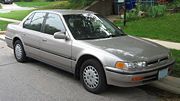
In 1993 Honda released the "10th Anniversary Edition" sedan, marking the 10th year for the Accord's US production. The 10th Anniversary Edition was essentially an Accord in LX trim with the addition of ABS, 4 wheel disc brakes, 15" alloy wheels, and body colored side moldings. An automatic transmission was standard. Only three colors were offered on the 10th Anniversary Edition: Frost White, Granada Black Pearl, and Arcadia Green Pearl. The SE returned for 1993 as both a sedan and for the first time as a coupe. Another Accord first, dual airbags standard, but only in the SE sedan, but not the coupe. The 1993 SE also has matching body color for side molding trims which the 1991 and 1992 doesn't (they are black). An 8-button, 4-speaker Honda-Bose music system, automatic transmission, leather trim and body colored bumper and body side moldings were standard. The SE coupe included a factory wing spoiler. In Canada, the SE came with heated front seats and side view mirrors. Both the sedan and coupe received distinctive 15" alloy wheels as well. All SE sedans in 1991 and 1993 were manufactured in Japan, while all SE coupes were produced in the US. The sedan was available in two colors: Cashmere Silver Metallic, and Geneva Green Pearl, both with Ivory interior. The coupe was offered with two colors as well: Cashmere Silver Metallic, and Atlantis Blue Pearl, both again with Ivory interior. Sadly, 1993 would be the swan song for the SE as an exclusive, high content, limited edition Accord model. Later generations would use the SE designation intermittently as a "special-edition" model, combining an Accord LX with several EX features.
At the end of the model life of the CB Accord, a "pilarred hardtop" model called the Honda Ascot Innova was launched in Japan, based on the CB Accord chassis, but with a different, much more modern-styled body, taking cues from the 1991 Honda Prelude.
[11] CB7Tuner, a large online forum community, is based on the fourth generation Accord and contains owners of fourth generations from all over the world.
Fifth generation (1994–1997)
Japanese and North American Accord
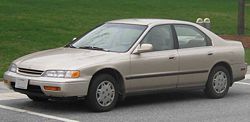 |
|
| Also called | Isuzu Aska |
|---|---|
| Production | 1994-1997 |
| Assembly | Marysville, Ohio, USA Sayama, Japan |
| Class | Mid-size |
| Body style(s) | 2-door coupe 4-door sedan 5-door station wagon |
| Engine(s) | 2.2 L F22B1 I4 145 hp (108 kW) 2.2 L F22B2 I4 135 hp (101 kW) 2.2 L F22Z2 I4 150 hp (112 kW) 2.7 L C27A V6 170 hp (127 kW) 2.2 L H22A I4 200 hp (CF2 SIR) |
| Transmission(s) | 4-speed automatic 5-speed manual |
| Wheelbase | 106.9 in (2715 mm) |
| Length | 1994-95 Wagon: 187.8 in (4770 mm) 1994-95 Sedan & Coupe: 184.0 in (4674 mm) 1996-97 Coupe & Sedan: 185.6 in (4714 mm) 1996-97 Wagon & V6 Sedan: 188.4 in (4785 mm) |
| Width | 70.1 in (1781 mm) |
| Height | 1994-95 Wagon: 55.9 in (1420 mm) Coupe: 54.7 in (1389 mm) Sedan: 55.1 in (1400 mm) 1996-97 V6 Sedan: 55.3 in (1405 mm) 1996-97 LX Wagon: 56.0 in (1422 mm) 1996-97 Wagon: 57.4 in (1458 mm) |
| Curb weight | 2,855 lb (1,295 kg) |
| Fuel capacity | 17 US gallons (64.4 L/14.2 imp gal) |
| Related | Acura CL Acura TL Acura Vigor Honda Inspire Honda Ascot Honda Odyssey |
In 1994, the Honda Accord was moved to a yet larger "CD" chassis, primarily to better suit the requirements of the North American market. It grew in width but oddly shrunk in length, leaving it classified as a mid-size car in North America. It thus became too wide to fit within the favorable tax bracket in Japan, where its role was to be partially taken over by the smaller second-generation Honda Ascot and Honda Rafaga.
DX, LX and EX remained the American trim lines while Canada retained the EX-R. The 5-speed manual remained mostly unchanged; the 4-speed automatic transmission, noted for its hard shifts, now included a "Grade-Logic" shift program. All Accord models received a more ergonomic interior with standard safety features such as dual airbags and reinforced side-impact beams. Exclusive to the EX was a VTEC version of the 2.2-liter 4-cylinder (making 145 hp (108 kW) instead of 130), antilock brakes (now an option for the LX), 15" alloy wheels (instead of 14" steel), 4-wheel disc brakes, and a rear stabilizer bar; leather was an EX option. The Accord was named Motor Trend Import Car of the Year. The Accord coupe looked almost exactly like the sedan; this was the last generation of Accord to offer a wagon variant in America.
In 1995, the Accord debuted a V6 engine, the 2.7 L C27 from the Acura Legend, in the U.S. market. The V6 was offered in the LX and EX versions of the sedan. Both versions of the V6 received a dual-outlet exhaust, a 4-speed automatic transmission, 15" wheels and a slightly updated front grille. The Accord saw very little other changes in 1995 with the exception of a few different exterior/interior color combinations. Some versions sold in New Zealand had a 2.4-litre 4-cylinder while the 2.7 V6 was offered in EX trim only.
In 1996, the Accord underwent the usual mid-generation facelift. More rounded bumpers, a slightly modified front fascia with new signal lights and rear taillights give the Accord a softer look. All Hondas now complied with the Federal Government's requirement of OBD II engine diagnostics though all three engine choices remained the same. In order to increase the Accord's competitiveness against its rivals in different international markets, Honda CEO Nobuhiko Kawamoto decided on one basic platform for the sixth-generation Accord, but with different bodies and proportions for local markets. In the United States the 1996 model lineup included the 25th Anniversary Edition, a model between the DX and LX.
In 1997, Honda released the "Special Edition" version of the Accord (not to be confused with the SE). It was offered in three colors: Heather Mist Metallic, San Marino Red and Dark Currant Pearl. The Special Edition received a factory installed security system with keyless entry, single-disc CD player, body colored side molding, distinctive alloy wheels and a sunroof. It was offered in an automatic transmission only and was fitted with the same engine as the LX.
European Accord
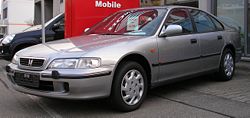 |
|
| Also called | Honda Ascot Innova |
|---|---|
| Production | 1994-1997 |
| Assembly | Swindon, England |
| Class | Mid-size |
| Body style(s) | 4-door sedan |
| Related | Rover 600 |
The launch of the fifth generation also marked the first time Honda marketed a Europe-only Accord model, made in its Swindon factory in the United Kingdom. The European Accord sedan was, however, not related directly to the CD Accords, but rather to the previous CB Accord, as it was a slightly reworked version of the above mentioned Honda Ascot Innova. The Swindon-built Accord sedan was accompanied in European markets by the coupe and Aerodeck estate imported from the US. Concurrently, the British Rover Group, Honda's partner at that time, launched a model called Rover 600, which was developed together with the European Accord sedan.
Sixth generation (1998–2002)
For the sixth generation, Honda split the Accord into three separate models, manufactured and sold in its most important markets.
Japanese Accord
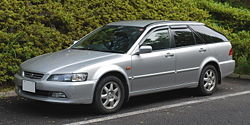 |
|
| Production | 1998-2002 |
|---|---|
| Assembly | Sayama, Japan Guangzhou, China |
| Class | Mid-size |
| Body style(s) | 4-door sedan 5-door wagon |
| Related | Honda Torneo |
The JDM Accord became narrower than the previous generation, returning to the favorable "size 5" tax bracket. A nearly identical sister car, the Honda Torneo, superseded the Honda Ascot and the Honda Rafaga in Japan. While the Aerodeck was discontinued in North America, Honda developed a wagon version of the JDM model, for sale mainly in Japan.
North American Accord
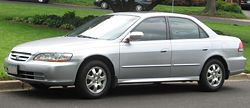 |
|
| Also called | Isuzu Aska |
|---|---|
| Production | 1998-2002 |
| Assembly | Marysville, Ohio, USA Sayama, Japan |
| Class | Mid-size |
| Body style(s) | 4-door sedan (US body, chassis no. CG5/CG6) 2-door coupe (US body, chassis no. CG2/CG3) |
| Engine(s) | '2.3 L F23A1 I4 150 hp (112 kW) 2.3 L F23A5 135 hp (101 kW) 3.0 L J30A1 V6 200 hp (150 kW) |
| Transmission(s) | 4-speed automatic 5-speed manual |
| Wheelbase | Sedan: 106.9 in (2715 mm) Coupe: 105.1 in (2670 mm) |
| Length | 1998-2000 Sedan: 188.8 in (4796 mm) 2001-02 Sedan: 189.4 in (4811 mm) 1998-2002 Coupe: 186.8 in (4745 mm) |
| Width | 70.3 in (1786 mm) |
| Height | 1998-2002 Sedan: 56.9 in (1445 mm) 1998-2002 V6 Sedan: 57.3 in (1455 mm) 1998-2000 Coupe: 55.1 in (1400 mm) 2001-02 Coupe: 54.9 in (1394 mm) 2001-02 V6 Coupe: 55.3 in (1405 mm) |
| Curb weight | 2,990 lb (1,356 kg) |
| Fuel capacity | 17.1 US gallons (64.7 L/14.2 imp gal) |
| Related | Acura CL Acura MDX Acura TL Honda Inspire Honda Odyssey |

The American Accord was only available in sedan and coupe form, becoming the largest Accord to date, sharing a platform with the Acura TL and the JDM Honda Inspire. While previous generations of the Coupe were considered two-door versions of the sedan, the 1998 Coupe was the first to be given an exclusive front fascia, rear tail lights, wheels and many other body panels, and was now marketed as a somewhat separate model, the "Accord Coupe", to set it away from the more family-oriented sedan version. It also allowed the Coupe, which was exported to other markets, to fit in more easily with the local Accord versions. [6]

For the 1998 model year, the sedan was offered DX, LX, EX, and EX-V6 trims while the Accord Coupe was offered only in LX, EX, and EX-V6 trims. In 1999, the LX-V6 sedan and coupe were added to the model lineup, at roughly the same MRSP as the EX. The DX model was fitted with a 2.3 liter, 130 hp (97 kW) 4 cylinder engine carried over from the past generation Accord, while the LX and EX trims included a more spirited 2.3 litre, 150 hp (112 kW) 4-cylinder VTEC engine. All 4-cylinder models came with a 5-speed manual transmission standard with a 4-speed automatic optional. The DX remained the value-oriented trim with no audio system, manual windows, manual locks, no cruise control, rear drum brakes, and 14" steel wheels. The DX Value-Package added a radio-cassette player, air conditioning, and cruise control; this was known as the Accord DX in Canada where it was the base model of the lineup. The LX trim added power windows, power locks, door courtesy lights and 15" steel wheels; a SE (special edition) package available since 1999 added ABS and 15 inch alloy wheels. The LX-V6 included all features of the 4-cylinder LX, while adding rear disc brakes, ABS, and 15 inch alloy wheels. The EX trim added a power sunroof, a single-disc radio/CD player, alloy wheels, keyless entry, rear disc brakes, ABS and upgraded cloth. Leather seating was a factory installed option for the EX. All V6 sedan and coupe models received the new 3.0 litre, 200 hp (150 kW)/195 lb·ft (264 N·m) torque SOHC VTEC engine, previously used in the Acura 3.0 CL. The EX-V6 received standard leather trim, ABS, automatic transmission, and fully automatic climate control. Some dealer-installed options included: Gold finish kit, gold finish exhaust tip(s), gold finish wheel center caps, 6-disc in-dash CD changer, tape deck, fog lights, wing spoiler, alarm system, sunroof visor, car cover and accessory chrome wheels.
In 2001, both the USDM Accord sedan and coupe underwent a minor facelift. A new front fascia, rear bumper, side skirt alteration, new taillights and wheel designs freshened the Accord's look. The interior saw few changes with the exception of some fabric and audio configuration changes. The LX and LX-V6 now included a standard CD player, and the EX and EX-V6 now included a 6-disc in-dash CD changer with cassette player and automatic climate control. EX-V6 models also included a traction control system that could be disabled by a switch, the first Accord to have such a system included. The Special Edition returned to the coupe and sedan models. It included all the features of the LX, but adds exclusive alloy wheels, ABS, keyless entry and a single CD/cassette radio.
Honda made the decision to continue this generation of Accord an extra year. Previously, the Accord ran four years on a single body-style and facelift before being redesigned. The typical Accord generation cycle was a 2:4 trend, with a newly released model running for years 1 and 2 unaltered, then getting a facelift for years 3 and 4 before a major redesign. This generation will run a total of 5 years in a 3:5 trend, with the facelift occurring in year four, and Accord sales remained steady despite the additional year.
Despite the Accord's reputation for stellar reliability, the V6 models were plagued by transmission failures and were even included in class action law suits against the company (4 cylinder models were also affected, but not to the same extent). This caused the Honda Corporation to extend the warranties for the 1998 through 2002 models to seven years or 100,000 miles (160,000 km). Yet no formal recall occurred. In Canada, recall letters were sent out to owners who fell within a certain VIN range, this warranty was later re-extended for some owners to 7 years 11 months in length.
- Beginning in 1998, Honda Accord keys were equipped with immobilizer microchips.
- In 1999, the Accord was given foldable mirrors.
- In 2002, the Special Edition was dropped and the DX Value-Package was re-introduced.
The 1998 Accord was also assembled in New Zealand at the very end of overall New Zealand CKD car production (due to changes in tariffs for car importation in that country). 1200 examples of the car (using the mid-sized U.S. sedan bodyshell) were produced before the Honda New Zealand factory was closed (the very first Honda owned factory operation to be closed down), production thereafter being imported from Thailand.
European Accord
| Production | 1998-2002 |
|---|---|
| Assembly | Swindon, England |
| Class | Mid-size |
| Body style(s) | 4-door sedan 5-door hatchback |
The European Honda Accord, also made in Swindon, became very different from its cousins in terms of styling, and was also shorter than the JDM and USDM Accords. It was available as a sedan and a 5-door hatchback (liftback), with the US-imported Coupe completing the range.
- The (CL1)Accord Euro R was also in 2001, featuring a 220 hp (164 kW) H-series (H22a7) engine, and 'R' features such as Recaro seats, LSD (Limited Slip Differential), sports suspension, and titanium gearknob.
- The Accord SiR-T featured in 1998, was powered by a rare 2.0 liter F-Series (F20B), which has 200 hp (150 kW)/144.5 lb·ft (196 N·m),11.0.1 compression, & revs to 8500 rpm unlike H-series V-tec engines that from factory is limited to 7800 rpms.
Seventh generation (2003–2007)
The seventh generation of the Accord was launched in 2002 (2003 model year in North America), and essentially consists of two separate models.
Japanese and European Accord
 |
|
| Also called | Acura TSX |
|---|---|
| Production | 2003–2007 |
| Assembly | Greater Noida, India Alor Gajah, Malaysia Sayama, Japan |
| Class | Mid-size |
| Body style(s) | 4-door sedan (JDM chassis no. CL7-CL9) 5-door wagon |
| Engine(s) | 2.4 L K24A4 I4 2.4 L K24A8 I4 |
| Transmission(s) | 5-speed automatic 5-speed manual 6-speed manual |
| Wheelbase | 2670 mm (105.1 in) |
| Length | Sedan: 4665 mm (183.7 in) Wagon: 4750 mm (187 in) |
| Width | 1760 mm (69.3 in) |
| Height | Sedan: 1445 mm (56.9 in) Wagon: 1495 mm (58.9 in) |
- See also: Acura TSX
The European and JDM Accords were integrated on the previous Japanese Accord's chassis, but with a new body. No longer made in Swindon, those Accords are all made in Japan, and come in both saloon and estate form. Although retaining the old chassis and wheelbase, the Accord grew in outside dimensions slightly, falling out of the size 5 tax band, and the Torneo version was discontinued. In some markets where both versions of the Accord are sold, such as in Australia, the JDM Accord is called "Accord Euro" to distinguish it from its USDM counterpart. The JDM Accord is also exported to North America, where it is sold as the Acura TSX, alongside the third-generation Acura TL which is based on the USDM Accord.
North American Accord
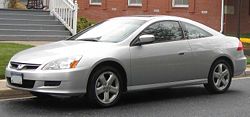 |
|
| Also called | Honda Inspire |
|---|---|
| Production | 2003–2007 |
| Assembly | Marysville, Ohio, USA Jalisco, Mexico Sayama, Japan Guangzhou, China |
| Class | Mid-size |
| Body style(s) | 4-door sedan (USA chassis no. CM5/CM6) 2-door coupe (USA chassis no. CM7/CM8) |
| Engine(s) | 2.4 L K24A4 I4 2.4 L K24A8 I4 |
| Transmission(s) | 5-speed automatic 5-speed manual 6-speed manual |
| Wheelbase | Sedan: 107.9 in (2741 mm) Coupe: 105.1 in (2670 mm) |
| Length | 2003-05 Sedan: 189.5 in (4813 mm) 2003-05 Coupe: 187.6 in (4765 mm) 2006-07 Sedan: 191.1 in (4854 mm) 2006-07 Coupe: 187.8 in (4770 mm) |
| Width | 2003-05 Sedan: 71.5 in (1816 mm) 2006-07 Sedan: 71.6 in (1819 mm) 2003-07 Coupe: 71.3 in (1811 mm) |
| Height | 2003-05 Sedan: 57.1 in (1450 mm) 2006-07 Sedan: 57.2 in (1453 mm) 2006-07 V6 Sedan: 57.3 in (1455 mm) 2003-07 Coupe: 55.7 in (1415 mm) 2006-07 V6 Coupe: 55.8 in (1417 mm) |
| Fuel capacity | 17.1 US gallons (64.7 L/14.2 imp gal) |
| Related | Acura TL Honda Odyssey Honda Pilot |
- See also: Honda Inspire
The North American Accord grew in size yet again, being available in sedan and coupe styles, though the coupe was not exported to either Europe or Japan under the Accord name. This model is also marketed as the Accord in parts of Asia (being assembled in China, Thailand, and Taiwan) and Latin America, as well as is exported from the USA to Japan to be sold as Honda Inspire. In some markets, both versions of the Accord are sold, e.g. in Australia where the smaller Japan-made Accord is called "Accord Euro" to distinguish it from the larger sedan. Now a vastly different car to the worldwide Accord, the North American model grew larger still, gaining more interior room and weight than its international counterpart. Honda sold the North American Accord in a few other markets including ASEAN (Southeast Asia)(now made in Thailand), Middle Eastern, Caribbean, Australian and New Zealand markets with mixed results.

The North American Accord was given a new level of refinement with chrome interior accents and higher grade materials.[7] The lineup still included the DX, LX, EX, LX-V6 and EX-V6 like the previous generation. Mechanically, the 4-cylinder engine was the new K-series, and the 6-cylinder was the same J-series V6 as the sixth generation's, but revisions to the intake and exhaust contributed to a 40 hp (240 hp) increase. One of these revisions was that the exhaust manifolds became part of the cylinder head casting. A 5-speed automatic transmission was also new for 2003. For the first time, Honda offered an "enthusiast" version of the Accord in the US, adding a sports suspension and mating the 6-speed manual transmission from the Acura CL to the V6 Honda Accord Coupe. A specific 4-cylinder model is the first production car in the world to meet California's Super Ultra Low Emission standards. The 2003 model year also debuted Honda's GPS assisted Navigation system as an option for the Accord. Prior to 2003, it was only available on the higher end Acura line as well as the Honda Odyssey. The first 2003 Honda Accord rolled off the Marysville, OH assembly line on September 26, 2002.
In 2004 Honda announced that they would release a hybrid version of the North American Accord called the Honda Accord Hybrid featuring Honda's IMA technology. In 2004 Honda also first offered XM Satellite Radio as a factory installed option.
For 2005, the Accord received several updates, including standard side curtain and front seat side impact airbags on all models, revised taillights (all red), more chrome on the grill, and new wheel designs. The Accord became Canada's top-selling mid-size car, and this was the first model year of the Accord Hybrid.
2006 Model Update
For its 2006 model year, which was its 30th anniversary, the North American Accord received a mid-generational refresh, though it was fairly significant and some enthusiasts called this generation 7.5.

The exterior was revised with a new front grill inspired by that of the eight-generation Civic which also debuted that year, new rear end styling with triangular LED taillights, daytime running lights (DRLs) and heated side mirrors for US EX models. Heated mirrors and DRLs were previously available only on Accords sold in Canada. The 2006 model year also featured new wheel designs, with 17" rims being standard on V6 models. Vehicle Stability Assist (VSA) (Honda's term for Electronic Stability Control) and Brake assist became available on the V6 models for the first time.
The interior was also slightly redesigned with changes such as a new steering wheel cover, differently colored gauges and a differently styled shift knob for automatic transmission models. The GPS Navigation system was updated (4th generation) with a faster processor, more memory, and several new features, such as restaurant information from Zagat. A revised maintenance minder system was also added which gave owners reminders for scheduled maintenance such as oil changes based on operating conditions.
Powertrain improvements were made across the Accord line-up in 2006. The V6 engine's power was increased to 244 hp (+4 hp, SAE net revised 8/04*) and the 4-cylinder engine's power was increased to 166 hp (+6 hp, SAE net revised 8/04*). Power gains were achieved with extensive improvements to the airflow of the intake and exhaust systems. The 4-cylinder engines were now controlled with Drive-By-Wire (DBW), rather than a throttle cable, providing for smooth operation and enhanced throttle response. (Accord V6 engines already utilized DBW prior to the 2006 model year). Due to these improvements the V6 engine was renamed the J30A5 from the previous J30A4, and the 4-cylinder from the K24A4 to the K24A8. For the Brazilian market, the 2.4L engine was dropped in favour of a smaller 2.0L 4-cylinder i-VTEC K20A engine generating 150 hp (112 kW). This was done to make the car more competitive against the newer Ford Fusion and Chevrolet Vectra. The 2006 model year is also the first year in which the V6 sedan was offered with a 6-speed manual transmission as an option.
The 2006 Accord Hybrid got the same revisions as the other Accords except for a 3.0 L V6 now making 253 hp (189 kW) and a larger battery pack. Features that differentiate the Hybrid from other Accords are the different rear light clusters, the antenna, the wheels, the mirror turn signals and the lack of a folding rear seat. In addition, the Hybrid version does not have the 4-way passenger seat.

The trim levels were also revised. The inexpensive no-frills Accord was no longer offered, with the DX trim being eliminated. The Accord base model was succeeded by the VP (Value Package) trim which included air conditioning, keyless entry, power windows, power locks, and cruise control as standard features, while also having body-colored door handles and mirrors. In Canada, sedans came as DX-G, SE, EX-L, SE-V6, EX-L V6, EX-L V6 6MT, and the Hybrid, while Coupe trims included the SE, EX-L, EX-L V6, and EX-L V6 6MT.
For its 2007 model year, a new SE-V6 trim was introduced and the color "Cool Blue Metallic" became available for the sedan. That color was previously only available for the coupe.
Eighth generation (2008–present)
Japanese and European Accord
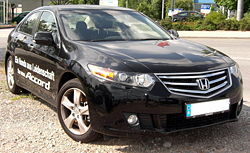 |
|
| Also called | Acura TSX |
|---|---|
| Production | 2008–present |
| Assembly | Guangzhou, China Sayama, Japan |
| Class | Mid-size |
| Body style(s) | 4-door sedan 5-door wagon |
| Engine(s) | 2.0L R20A3 I4[8] 2.4L K24Z2 I4 2.4L K24Z3 I4 2.2L N22A2 I4 Turbodiesel (2009-) |
| Transmission(s) | 5-speed automatic 5-speed manual 6-speed manual |
| Wheelbase | 2705 mm (106.5 in) |
| Length | Sedan: 4726 mm (186.1 in) Tourer: 4740 mm (186.6 in) |
| Width | 1840 mm (72.4 in) |
| Height | 1440 mm (56.7 in) |
- See also: Acura TSX
Honda revealed some detail shots and a teaser video of the European-spec Accord in January 2008, before debuting it at Geneva Motor Show in March. The new Accord comes in both saloon and wagon forms, offering a host of engine and transmission options. Available engines are the 2.0-litre and 2.4-litre i-VTEC petrol engines, as well as the 2.2-litre i-DTEC diesel engine. All engines come with a 6-speed manual transmission, while the petrol engines get in addition to that a 5-speed automatic transmission. Dimensionally, the Accord has become longer, wider, and lower for a sleek, sporty look, along with sharper body lines and slightly redesigned headlights. Honda has built the Accord on its new ACE body structure, available with a host of new safety features.
It went on sale in Japan and Europe in mid-2008. It is also available in US and Canada as the second-generation Acura TSX.
North American Accord
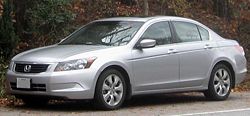 |
|
| Also called | Honda Inspire |
|---|---|
| Production | 2008–present |
| Assembly | Marysville, Ohio, USA Jalisco, Mexico |
| Class | Sedan: Full-size Coupe: Mid-size |
| Body style(s) | 4-door sedan 2-door coupe |
| Engine(s) | 2.0L R20A3 I4[9] 2.4L K24Z2 I4 2.4L K24Z3 I4 3.5L J35Z2 V6 2.2L N22A2 I4 Turbodiesel (2009-) |
| Transmission(s) | 5-speed automatic 5-speed manual 6-speed manual |
| Wheelbase | Sedan: 110.2 in (2799 mm) Coupe: 107.9 in (2741 mm) |
| Length | Sedan: 194.1 in (4930 mm) V6 Sedan: 194.3 in (4935 mm) Coupe: 190.9 in (4849 mm) |
| Width | Sedan: 72.7 in (1847 mm) Coupe: 72.8 in (1849 mm) |
| Height | Sedan: 58.1 in (1476 mm) Coupe: 56.4 in (1433 mm) |
| Related | Acura TL Honda Pilot Honda Odyssey |
- See also: Honda Inspire
The North American version of the Accord sedan remains a larger and different styled car than its European counterpart. The USDM Accord sedan is marketed as the Honda Inspire in Japan, as is with the previous generation, albeit with some minor interior and exterior changes.

The size of the 2008 Accord has been increased by 4 inches (102 mm) in length and 3 inches (76 mm) in width. As a result, the interior space is also enlarged: an Accord sedan is considered a full-size car by United States Environmental Protection Agency (EPA) standards, having a combined interior space of 120.0 cubic feet (3.40 m3) without moonroof and 115.0 cubic feet (3.26 m3) with. The Accord coupe is still classified as a mid-size car, as it has a combined interior space of 104.0 cubic feet (2.94 m3) without moonroof and 101.6 cubic feet (2.88 m3) with moonroof.
A hybrid version is no longer offered, as Honda felt their "hybrid system works better on smaller cars".[10] Instead, Honda offers a diesel engine version of the Accord starting in the 2009 model year,[11] which offers better fuel economy than the gasoline versions, and is 50-state emissions compliant. The Accord diesel for the US market was confirmed at the 2007 Tokyo Motor Show, and has been unveiled at the 2008 North American International Auto Show in Detroit, Michigan.
Honda has stated that the V6 models of the Accord features better fuel efficiency due to Honda's Variable Cylinder Management (VCM) system, which shuts off 2 or 3 of the cylinders depending on the type of driving (i.e. city driving, uphill/downhill driving, highway driving).[12] This is supposed to increase the efficiency of the V6 models while keeping the power at 268 hp (200 kW). The lack of VCM results in a decrease of 4 MPG in highway fuel economy. In addition to VCM, the new V6 model of the Accord features more advanced emissions control technology, and complies with the California "Partial Zero-Emissions Vehicle" (PZEV) category. PZEV models of the Accord are automatic only. The 2008 model year also drops the 6-speed manual transmission from the sedan version. VCM is not offered on the 6-speed manual transmission of the Accord Coupe V6.[13]
The Accord received several key safety updates for the 2008 model year, most notably standard traction control, vehicle stability assist (VSA), and active front head restraints for all models. These new safety features contributed to perfect crash test scores for the Accord, earning it a "Top Safety Pick" designation from the Insurance Institute for Highway Safety (IIHS), an honor not bestowed upon most of the Accord's competitors.
The 2008 Honda Accord coupe and sedan were officially unveiled on August 20, 2007.[14] Sales for the sedan started on September 12, 2007, while the coupe followed eight days later on September 20. The 2008 model has garnered mostly positive reviews, with some noting that its chiseled looks and Teutonic styling is remeniscent of BMW's 3 and 5 Series.[15][16][17] MotorTrend magazine criticized the car for being too heavy, feeling not so nimble as the previous model, its polarizing appearance, and for its less-than-stellar showing against the Chevrolet Malibu in their 2008 Car of the Year competition, highly uncharacteristic of the Japanese manufacturer. In its March 2008 issue, Car and Driver placed the 2008 Honda Accord first in a comparison test against the then recently redesigned/updated Toyota Camry, Nissan Altima, Chevrolet Malibu, Hyundai Sonata, and Dodge Avenger, as well as the Ford Fusion. Edmunds.com InsideLine also placed it in first in a comparison against the Nissan Altima, Toyota Camry, and Chevrolet Malibu, praising it for high build quality, responsive handling, and excellent fuel economy. The Accord is the top pick midsize vehicle in the Consumer Reports rankings, due to its standard stability control despite having a slightly lower score than the Nissan Altima, while Consumer Guide has named the Accord a "Best Buy".[18] The Accord also won Car and Driver's 10Best trophy in 2008 for the 22nd time, winning it more times than any other vehicle by far. US sales have been up 9.4%, as SUV buyers shift to the V6 Accord.[19]
In Canada, sedan trims include the LX, EX, EX-L, EX V6, and EX-L V6, while coupes have the EX, EX-L, EX-L V6, and EX-L V6 6MT. The LX designation was the de facto replacement for the VP and DX-G trims in the previous generation, while the EX replaced the SE. EX and more expensive trims include a power moonroof, 17-inch alloy wheels, 8-way adjustable driver's seat, security system, and a 6-disc CD changer. EX-L denotes Accords with leather upholstery, XM satellite radio, and an optional navigation system and hands-free Bluetooth interface. The EX-L V6 coupe has 18-inch alloy rims, a rear lip spoiler, and an option of the six-speed manual in lieu of the standard five-speed automatic transmission. V6 models have chrome handles and fog lamps. In the United States, additional models offered include the LX-P sedan (adds the 8-way driver's seat and 16-inch alloys) and LX-S coupe (which replaces the 177-hp engine with a 190-hp, 17" alloy wheels, 6 disc cd changer, 4 disc brakes)[20].
The 2009 model year increases the power of the six cylinder models to 271 hp (202 kW).
This version of Accord is also being sold in Southeast asia and Australia market with vehicles manufactured in Thailand. The Japanese built Accord is sold on the Australian market as the Accord Euro.
Restricted PZEV Sales
Due to a smaller profit margin on a PZEV for the manufacturer, Honda has forbidden sales of the V6 Partial Zero Emissions Vehicle version of the car outside California, Florida, Vermont, Connecticut, Arizona, Maryland, Massachusetts, Pennsylvania, New York, Oregon, Maine, New Jersey, Rhode Island, New Mexico and Washington.[21]
Sales
Monthly U.S. Sales
| Jan 2008 | Feb 2008 | Mar 2008 | Apr 2008 | May 2008 | Jun 2008 | Jul 2008 | Aug 2008 | Sep 2008 | Oct 2008 | Nov 2008 | Dec 2008 | 2008 Total |
|---|---|---|---|---|---|---|---|---|---|---|---|---|
| 23,957 | 27,631 | 36,214 | 34,628 | 43,728 | 39,704 | 41,382 | 43,613 | 22,371 | 19,783 | 333,011 | ||
| Jan 2007 | Feb 2007 | Mar 2007 | Apr 2007 | May 2007 | Jun 2007 | Jul 2007 | Aug 2007 | Sep 2007 | Oct 2007 | Nov 2007 | Dec 2007 | 2007 Total |
| 25,714 | 30,370 | 36,506 | 28,926 | 31,915 | 28,915 | 37,142 | 47,360 | 35,031 | 30,936 | 28,161 | 31,255 | 392,231 |
| Jan 2006 | Feb 2006 | Mar 2006 | Apr 2006 | May 2006 | Jun 2006 | Jul 2006 | Aug 2006 | Sep 2006 | Oct 2006 | Nov 2006 | Dec 2006 | 2006 Total |
| 22,046 | 25,285 | 29,623 | 31,608 | 36,967 | 32,587 | 38,043 | 34,504 | 27,759 | 23,645 | 22,488 | 29,886 | 354,441 |
| Jan 2005 | Feb 2005 | Mar 2005 | Apr 2005 | May 2005 | Jun 2005 | Jul 2005 | Aug 2005 | Sep 2005 | Oct 2005 | Nov 2005 | Dec 2005 | 2005 Total |
| 20,074 | 24,222 | 33,075 | 35,235 | 30,698 | 32,928 | 36,129 | 46,153 | 33,884 | 26,977 | 23,548 | 26,370 | 369,293 |
| Jan 2004 | Feb 2004 | Mar 2004 | Apr 2004 | May 2004 | Jun 2004 | Jul 2004 | Aug 2004 | Sep 2004 | Oct 2004 | Nov 2004 | Dec 2004 | 2004 Total |
| 25,402 | 26,731 | 31,098 | 31,261 | 43,589 | 34,025 | 37,315 | 37,878 | 30,346 | 27,489 | 23,392 | 38,244 | 386,770 |
| Jan 2003 | Feb 2003 | Mar 2003 | Apr 2003 | May 2003 | Jun 2003 | Jul 2003 | Aug 2003 | Sep 2003 | Oct 2003 | Nov 2003 | Dec 2003 | 2003 Total |
| 27,449 | 29,335 | 35,863 | 33,202 | 37,210 | 30,817 | 38,552 | 49,098 | 33,072 | 28,866 | 27,843 | 26,443 | 397,750 |
| Jan 2002 | Feb 2002 | Mar 2002 | Apr 2002 | May 2002 | Jun 2002 | Jul 2002 | Aug 2002 | Sep 2002 | Oct 2002 | Nov 2002 | Dec 2002 | 2002 Total |
| 25,947 | 26,735 | 32,324 | 31,349 | 32,131 | 33,117 | 41,152 | 48,269 | 33,312 | 32,816 | 30,058 | 31,770 | 398,980 |
Awards
- The 2006 Honda Accord was ConsumerSearch's Best Family Car in Family Sedans in June 2006.[22]
- Motor Trend's Import Car of the Year for 1994.[23]
- Car and Driver's 'Recipient of 10 Best recognition for 22 of the last 25 years'.[24]
- Winner of Intellichoice's Best Overall Value of the Year in the midsize class (2003, 2006).[25][26]
- Voted Car of the Year Japan in 2002, 1993 and 1985.[27]
- Wheel Magazine's Car of the Year for 1977.[28]
See also
- Honda Accord Hybrid
- Cog
References
- ↑ 2008 Honda Accord vs. 2007 Toyota Camry - Head to Head - Motor Trend
- ↑ http://www.gizmag.com/go/5657/
- ↑ large size car
- ↑ Honda (September 4, 1997). "Accord--Accord, Torneo, Accord Wagon". Press release.
- ↑ grandJDM » Old School JDM Sat-Nav
- ↑ 1998-2002 Honda Accord Review
- ↑ CanadianDriver: Test Drive - 2003 Honda Accord EX-L sedan
- ↑ 2008 Honda Accord 2.0 VTi Review
- ↑ 2008 Honda Accord 2.0 VTi Review
- ↑ http://www.cnn.com/2007/AUTOS/06/05/honda_dropping_hybrid/index.html|1
- ↑ 2009 Honda Accord Diesel and New Honda Hybrids for 2009 - Car News / Green Machines / Car Shopping / Hot Lists / Reviews / Car and Driver - Car And Driver
- ↑ Honda Accord Family - 2008 - the Official Honda Web Site
- ↑ All-New 2008 Honda Accord Emphasizes Technology, Safety and Performance Within an Expressive and Spacious Design - Honda - Press Releases - Selected Story
- ↑ http://jalopnik.com/cars/new-cars/2008-honda-accord-revealed-291565.php jalopnik.com - 2008 Honda Accord Revealed!
- ↑ [1]
- ↑ [2]
- ↑ [3]
- ↑ 2008 Honda Accord Road Test - Consumer Guide Automotive
- ↑ [4]
- ↑ http://automobiles.honda.com/accord-coupe/price.aspx?Model=CS1139EW
- ↑ Can this be true, does the Clean Air Act stop most of us from buying clean cars? - AutoblogGreen
- ↑ ConsumerSearch's Best Family Sedans Review June 2006.
- ↑ [5]
- ↑ [6]
- ↑ [7]
- ↑ [8]
- ↑ [9]
- ↑ [10]
External links
- Honda Accord - Official US site
- Honda Accord Saloon - Official UK site
- Honda Accord Tourer - Official UK site
- Honda Accord - worldwide site
- Wikicars: Honda Accord
- Honda Accord History
|
|||||||||||||||||||||||||||||||||||
| — Honda road car timeline, 1980s–present | ||||||||||||||||||||||||||||||
|---|---|---|---|---|---|---|---|---|---|---|---|---|---|---|---|---|---|---|---|---|---|---|---|---|---|---|---|---|---|---|
| 1980s | 1990s | 2000s | ||||||||||||||||||||||||||||
| 0 | 1 | 2 | 3 | 4 | 5 | 6 | 7 | 8 | 9 | 0 | 1 | 2 | 3 | 4 | 5 | 6 | 7 | 8 | 9 | 0 | 1 | 2 | 3 | 4 | 5 | 6 | 7 | 8 | 9 | |
| Kei car | City/Jazz | Today | Today | Life | Life | |||||||||||||||||||||||||
| Subcompact | City | City | City/Logo | Fit/Jazz/City/Fit Aria | Fit/Jazz/City/Fit Aria | |||||||||||||||||||||||||
| Ballade | Ballade | Concerto | Domani | |||||||||||||||||||||||||||
| Civic | Civic | Civic | Civic | Civic | ||||||||||||||||||||||||||
| Compact | Civic | Civic | ||||||||||||||||||||||||||||
| Accord | Accord | Accord | Accord | Accord | ||||||||||||||||||||||||||
| Mid-size | Accord | Accord | Accord | |||||||||||||||||||||||||||
| Inspire | Inspire | Inspire | Inspire/Accord | |||||||||||||||||||||||||||
| Full-size | Inspire/Accord | |||||||||||||||||||||||||||||
| Legend | Legend | Legend | Legend | Legend | ||||||||||||||||||||||||||
| Coupé | CRX | CRX | del Sol | Insight | ||||||||||||||||||||||||||
| Integra | Integra | Integra | Integra | |||||||||||||||||||||||||||
| Prelude | Prelude | Prelude | Prelude | Prelude | ||||||||||||||||||||||||||
| Sports | Beat | S2000 | ||||||||||||||||||||||||||||
| NSX | ||||||||||||||||||||||||||||||
| Mini SUV | HR-V | |||||||||||||||||||||||||||||
| Crossroad | ||||||||||||||||||||||||||||||
| Compact SUV | Passport | |||||||||||||||||||||||||||||
| Compact Crossover SUV | Element | |||||||||||||||||||||||||||||
| CR-V | CR-V | CR-V | ||||||||||||||||||||||||||||
| Mid-size CUV | Pilot | Pilot | ||||||||||||||||||||||||||||
| Luxury CUV | MDX | |||||||||||||||||||||||||||||
| Compact MPV | Edix/FR-V | |||||||||||||||||||||||||||||
| Stream | Stream | |||||||||||||||||||||||||||||
| Airwave | ||||||||||||||||||||||||||||||
| Minivan | Stepwgn | Stepwgn | Stepwgn | |||||||||||||||||||||||||||
| Odyssey | Odyssey | Odyssey | ||||||||||||||||||||||||||||
| Pickup | Acty | Acty | Acty | |||||||||||||||||||||||||||
| Ridgeline | ||||||||||||||||||||||||||||||
| Honda road car timeline, North American market, 1990s–present | ||||||||||||||||||||
|---|---|---|---|---|---|---|---|---|---|---|---|---|---|---|---|---|---|---|---|---|
| Type | 1990s | 2000s | ||||||||||||||||||
| 0 | 1 | 2 | 3 | 4 | 5 | 6 | 7 | 8 | 9 | 0 | 1 | 2 | 3 | 4 | 5 | 6 | 7 | 8 | 9 | |
| Subcompact | Insight | |||||||||||||||||||
| Civic | Civic | Civic | Fit | Fit | ||||||||||||||||
| Compact | Accord | Civic | Civic | |||||||||||||||||
| Mid-size | Accord | Accord | Accord | Accord | ||||||||||||||||
| Sports | CR-X | del sol | S2000 | |||||||||||||||||
| Prelude | Prelude | Prelude | ||||||||||||||||||
| SUV | Element | |||||||||||||||||||
| CR-V | CR-V | CR-V | ||||||||||||||||||
| Passport | Passport | Pilot | Pilot | |||||||||||||||||
| Pickup | Ridgeline | |||||||||||||||||||
| Minivan | Odyssey | Odyssey | Odyssey | |||||||||||||||||